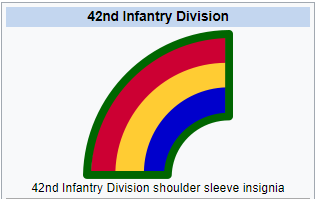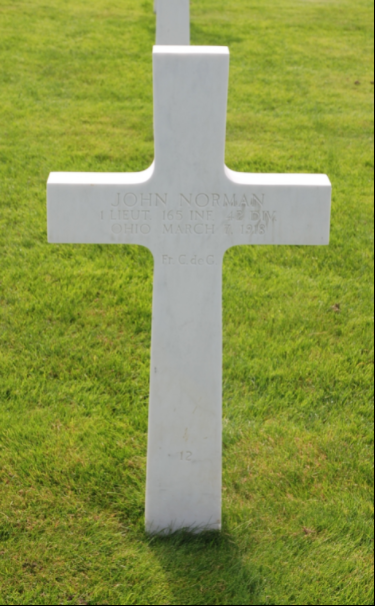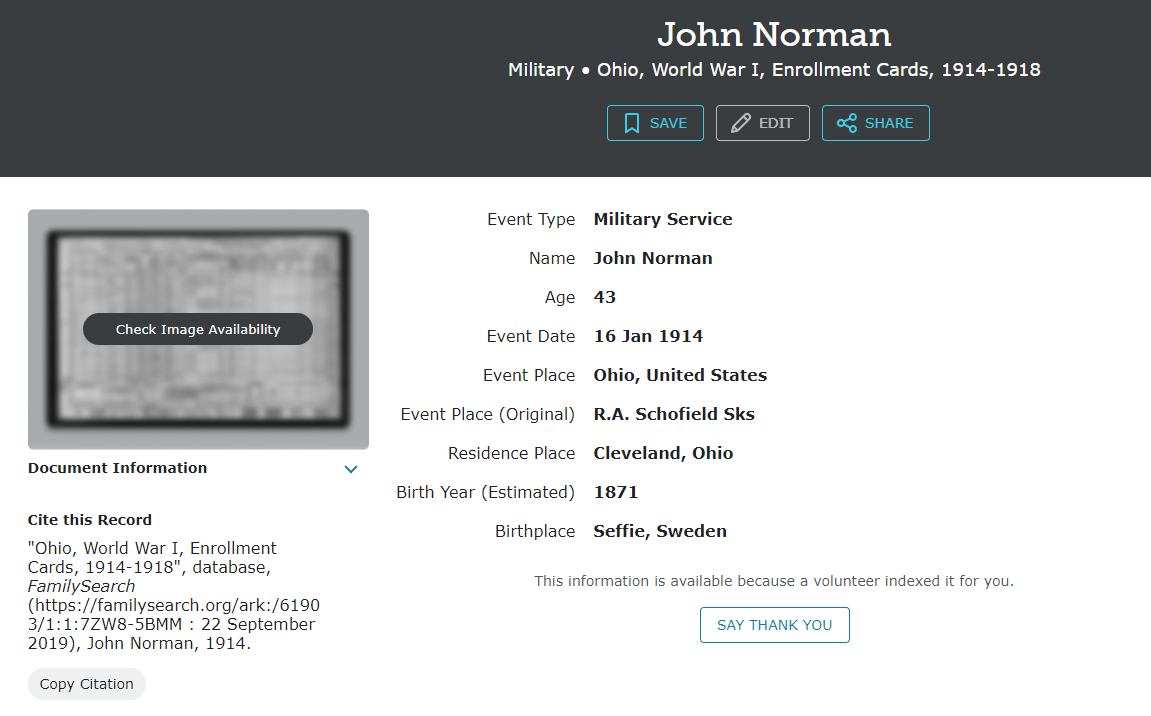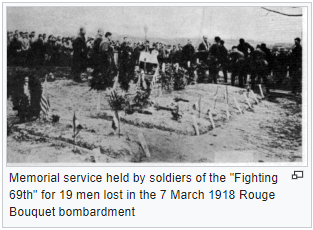One evening I was working with my research, and was looking for some names with a kind of Scandinavian connection, and just went back to cards that I had overlooked before. I then discovered a casualty card with the name John Norman, 1st Lt in the 165th Infantry, 42nd Division, called “the Rainbow Division”, American Expeditionary Force. (AEF)
The unit spent March 1918 under French command to gain experience about Trench warfare.
According to the card John was killed in action March 7th, 1918, as I though was quite early in the period for the AEF in France. I decide to look it up and found information about a story I havent heard about before. John was killed at an age of 47.
According to some sources John is born in Säffle in Sweden, which is in Värmlands län, in the western part of Sweden, just west of the big lake Värnern. It is told that he is born March 25th, 1870, and I am now trying to find more information that can confirm this, which for the moment is a bit hard. In this case I am looking through church book from that region, but I think Säffle can come from the fact that his brothers adress is Säffle on the casualty card, and that type of information has the tendence to “walk around” and become a fact that may not be connected to the person itself. I am also looking into other dates of birth.
The story about when he lost his life at the Western Front is very sad to read, and as I understand now, it is quite many stories written about this situation. Below you cand find some word from one of the stories. It was the first week at the battlefield for the personnel in the New York National Guard 69th Infantry, called “Fighting sixty-Ninth”, a unit with Irish heritage, the name was given to the unit in the American Civil War, by Robert E Lee.
“At about 3:20 p.m. the enemy launched a barrage of shells in the 2nd Battalion’s position for about an hour,” wrote Richard Demeter in his 2002 history of “The Fighting 69th.” With the majority of troops below ground in hardened dugouts for protection, tragedy struck when a German shell landed on and collapsed the dugout where 1st Lt. John Norman, a regular Army officer and his two dozen Soldiers of 1st Platoon were stationed.
The dugout was some 40 feet below ground, with timbers to protect the Soldiers, and numerous turns down a stairwell to the entrance.
“Tons of earth and stone cascaded,” recalled Pvt. Alf Helmer, a native of Norway and one of the few survivors of the barrage, explained in the 2008 Stephen Harris book “Duffy’s War.”
“I remember only the crash,” Helmer recalled. “Thoughts ceased. I only know that I found myself in the doorway of the forward entrance, hands extended over my head.”
Maj. William Donovan, commander of the regiment’s 1st Battalion, was visiting the 2nd Battalion command post after the relief in place when the barrage struck. Donovan volunteered to make an assessment and assist in the rescue efforts of the imperiled 1st Platoon.
Initial efforts were able to recover seven Soldiers, two alive and five dead. Donovan and a rescue team could still hear other survivors, including Lt. Norman, from the crater of earth and timber.
Not all of the New York Soldiers perished in the initial blast that collapsed the dugout, Helmer would later recall in the Harris book’s account. Half the platoon had survived, but with little space for air and tons of earth and debris, Helmer expected everyone to die as he frantically used his own helmet to scoop away dirt and create space to breath.
“Choking dust and gas stench filled the suffocating darkness,” Helmer’s son recalled for an interview for the Harris book. “I gave myself to prayer and making my peace with God, I was no longer afraid.”
Under intense German artillery fire, including a gas attack, the frantic efforts to dig into the crater and save their fellow Soldiers continued, assisted by the regiment’s engineers of the Pioneer Platoon. Sgt. Abram Blaustein, one of the estimated 60 – 80 Jewish Soldiers serving in the Irish regiment, helped to lead the rescue efforts.
“The Pioneers were called out to try to rescue these men,” recalled Al Ettinger in his account to his son in the 1992 book “A Doughboy with the Fighting 69th.”
“All night long we labored. Two lieutenants have general direction but it was Abe Blaustein who really took charge and led by example. The men worked in relays, but Blaustein always took the most dangerous position,” Ettinger said.
For his heroic actions, Sgt. Blaustein received the French Croix de Guerre and the moniker “Blaustein of the Irish.”
Donovan also received the Croix de Guerre for his actions in leading rescue efforts under fire.
The trauma of the loss and the determination to act even touched the survivors. Pvt. Helmer, once rescued, moved on to the medical aid station and the battalion command post to report on the tragedy. Then, according to Harris in “Duffy’s War,” he requested permission to return to the site to assist with rescue efforts.
“I knew that unless I saw the thing through,” Helmer said, “I would never again be able to look my comrades in the face.”
As rescue efforts the following morning became too dangerous under the German artillery barrage, and no further sounds came from the dugout, it was decided to halt work and leave the remaining 14 Soldiers and 1st Lt. Norman where they were buried. The regiment placed a marker and moved on.”
Text from army.mil.
The story has also been the base for a movie “The Fighting 69th”. A small clip on Youtube here:
I will now try to search further on in the archives, trying to find information that confirms that he is born in Sweden. The confirmation is an important part in my research.










